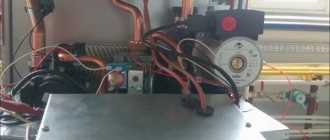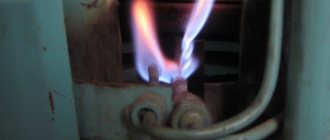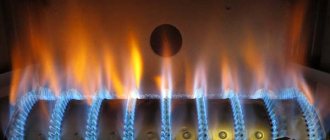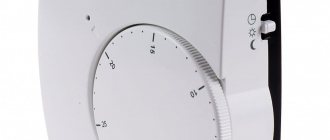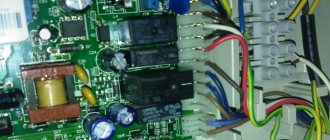Lemax gas boilers seriously compete with their European counterparts.
They are assembled from spare parts manufactured by recognized leaders in the production of heating equipment - Vaillant, Sit and other well-known manufacturers.
With excellent quality, the cost of Lemax boilers is two or more times lower than that of the “Europeans”.
Basically, this is achieved by eliminating all additional devices and components from the design, leaving only the most necessary elements.
This has a positive effect on the performance of the units, reduces the frequency of breakdowns or failures, but some malfunctions still occur.
Operating instructions for the Lemax gas boiler
For proper operation of the device, you must follow the rules of its operation.
First of all, you should pay attention to the room in which you plan to install it. It must be spacious, at least 8 m², and well ventilated
To install a floor-standing model, in order to prevent the floor from catching fire, the following rules must be observed:
- lay a sheet of non-flammable heat-insulating material at the installation site;
- on top of it is a sheet of iron and only then a cauldron.
In this case, it is worth considering the distance of the device body from the walls: at least 150 mm at the rear, 100 mm at the sides and 1000 mm at the front. The boiler is connected to the gas main using threaded pipes, which will allow it to be disconnected if necessary.
Important! The Lemax boiler requires the presence and connection to a chimney facing the street
Prices: summary table
| Model | Heat exchanger material | Available power, kW | Efficiency, % | Cost, rub. |
| Floor-standing | ||||
| Premium | steel | 7,5; 10; 12,5; 16; 20; 25; 30; 35; 40; 50; 60; 70; 80; 90; 100 | 90 | 23 700-95 000 |
| Leader | cast iron | 16, 25, 40, 50 | 90 | 60 500-70 000 |
| Wise | cast iron | 16, 25, 35, 40 and 50 | 90 | 57 000-81 300 |
| Clever | steel | 20, 30, 40, 55 | 90 | 32 000-75 000 |
| AOGV "Gazovik" | steel | 6; 8; 11,6; 13,5; 15,5; 23,2; 29 | 86 | 13 800-24 000 |
| Wall mounted | ||||
| Prime-V | copper | 10, 12, 14, 16, 18, 20, 24, 26, 28, 32 | 92,5 | 31 500-40 000 |
| Prime-C (condensing) | steel | 24 | 108 | 46 800 |
| Parapet | ||||
| Patriot | steel | 6; 7,5; 10; 12,5; 16; 20 | 87 | 21 900-25 000 |
Turning on the gas boiler
A prerequisite for warranty service of a gas boiler is that the first switch-on must be carried out exclusively by a specialist from the gas service. If the user follows all instructions and safety precautions when starting up independently, then you can also count on the reliability and durability of the heating system.
The initial start-up of a wall-mounted boiler is carried out strictly after checking the following points.
The first thing you need to do is make sure that the gas pipes are tight when the gas valve is closed and open. If gas flow is not recorded within 10 minutes after connecting all pipes, then it can be stated that the system is sealed.
The gas supplied from the main pipeline must meet the requirements specified in the instructions for the boiler. When transferring the unit to process a liquefied mixture, you need to change the nozzles in advance.
You also need to check the pressure level in the system. It should be as recommended. The air intake and carbon dioxide exhaust pipes should be checked for blockages.
Sometimes users encounter the problem of poor circulation of the pump. Often the cause is low mains voltage. This problem is solved by installing a stabilizer
It is necessary to make sure that the room with the boiler has a working ventilation system. Additionally, the smoke pressure safety switch is checked.
After carrying out the preliminary work, the procedure for starting the boiler follows:
- The gas boiler is connected to the network, the gas supply to the device is opened;
- Check that all valves at the inlet and outlet of the coolant into the unit are open;
- Press the button or turn the switch on the boiler dashboard depending on the switching method specified in the instructions.
You can adjust the temperature using the corresponding buttons. Working in automatic mode, the boiler independently turns on the burner if it is necessary to heat the water in the system. If the boiler is double-circuit, then when hot water is turned on, the burner automatically turns on for heating.
On the boiler display, after the initial start-up, it is recommended to configure all boiler parameters. The instructions usually indicate the sequence of necessary actions.
The interlock system cuts off the gas supply if the burner does not ignite within approximately ten seconds. When starting for the first time, it may be necessary to remove the ignition lock due to the presence of air in the gas line. You need to wait until the air is replaced by gas. The lock is removed when the device is restarted.
To start a floor-standing gas boiler, you need to carry out the same preparatory procedures as for a wall-mounted one. Before starting up, you need to ventilate the boiler room, make sure that all heating pipe taps are open and that there is draft in the chimney. You can check the traction using a piece of paper.
There are two options for turning off a floor-standing gas boiler. You can turn off only the main burner or the main burner together with the pilot
Switching on the floor-standing boiler:
- The door of the device is opened, the position of the boiler control knob is checked in the off position.
- The gas supply valve opens.
- The control knob is set to the piezo ignition position.
- Next, press the handle for 5 - 10 seconds so that the gas passes through the pipes and displaces the air. The piezo ignition button is pressed.
- Then the presence of a flame in the burner is checked. If the burner does not light, the procedure is repeated.
After igniting the main burner, you can use the control knob to adjust the heating temperature.
Automation block
The gas valve plays a key role here. It is controlled by analog sensors (in non-volatile versions) or electronic controllers that receive data from electronic sensors (in volatile versions).
The combined type valve is assembled from two valves - simple and electromagnetic. The first is held open by a spring. During startup, the second valve opens by pressing a button to light the wick. It is held for some time - the igniter warms up a special element - one that reacts to heat. This element begins to generate electric current - it holds the solenoid valve open, the user can release the button. When the igniter is blown out, the thermoelement cools down - the generation of electric current will stop, and the solenoid valve will close. The other valve, with a spring, will close after receiving a signal from the draft and temperature sensors.
User manual
There is no doubt that Lemax boilers can show their best side. But a lot depends on the consumers themselves, whether they comply with the instructions or not
And the most important thing begins even before the moment when there is a need to light the installed boiler. It is required to choose strictly equipment that matches the power of the heated room
Since exceeding the operating pressure is very dangerous, it is imperative to install a relief valve and set it properly.
The following actions are not allowed:
- introducing water into the system while the combustion chamber is running, as well as after it is stopped - until the coolant cools to less than +50 degrees;
- using a boiler when circulating coolant cooled to +50 degrees or less;
- use of heating devices with automatic components without grounding;
- installation of gas boilers, their commissioning, prevention and any technical manipulations by persons who do not have official permission;
- the use of devices in conjunction with smoke ducts that do not correspond to them;
- covering ventilation duct grilles.
You can turn on any boiler from the “Premium” collection or another series only after connecting it to the chimney; be sure to also prevent it from blocking and disrupting normal draft. You should also check that the entire heating system is filled with water, that it is not blocked anywhere by valves or air pockets. In the event of a serious failure of the automation, you should immediately turn off the boiler, and also leave all attempts to start it until the defects are eliminated by professionals. If the coolant warms up to more than +95 degrees, the boiler is also turned off and the cause of overheating is eliminated independently or with the help of hired specialists.
In advance, at the stage of selecting and installing equipment, it is necessary to prepare high-quality natural ventilation. It is recommended to install a steel sheet not only in front of the firebox, but also under the boiler itself, as well as around it around the perimeter.
If there was already a boiler or stove installed before, then during installation without replacing pipes and radiators, they should be washed. Violation of this requirement means that all claims regarding pipe capacity, heating of the coolant and the room, and water circulation will not be accepted. When starting up a gas boiler, first turn the knob and only after that start adjusting and starting. The time to initiate gas ignition ranges from 10 to 60 seconds, depending on a number of parameters that are unpredictable in a particular case. After the end of the annual heating phase, you cannot drain the water from the boiler itself and the heating lines - this threatens rapid and severe corrosion.
The lineup
The selection of heating equipment offered by Lemax is so wide that almost any buyer can find in its catalogs the optimal boiler model for themselves.
The products are produced in several series.
Each series includes both pure heating boilers (single-circuit) and those with a water heater function (double-circuit).
Premium Series
Lemax floor- and wall-mounted gas boilers with a steel heat exchanger and non-volatile automation. The younger representative of the line develops power up to 7.5 kW, the older one – up to 60 kW. In order to increase corrosion resistance, the heat exchanger is coated with enamel and special inhibitor compounds.
Leader Series
The products presented in this line are the most modern and expensive. Cast iron heat exchangers are used, which are much superior to steel ones in terms of durability - their service life is 25 years. The boiler can be equipped with both electronic and non-volatile automation.
The power of Leader series boilers varies from 16 to 50 kW.
Lemax Leader
Premium Nova Series
This series differs from the “Premium” series in its more “advanced” automation, powered by electricity. Her Lemax company is supplied by the famous Italian concern SIT Group (EuroSIT series automation).
This system allows you to connect a room thermostat, and some of its modifications also allow you to connect an outdoor temperature sensor (weather-compensated automation).
Catalytic emitters
The key feature of gas burners with catalytic emitters is their extremely high efficiency, which reaches almost 100%. To make the heating element, fiberglass is used, which is subsequently coated with a platinum layer.
Catalytic heaters are fireproof and environmentally friendly - fuel burns without open fire, so there are no harmful emissions. The working process is almost silent, and the air heating rate is quite high, so the entire volume of the tent heats up very quickly.
The cost of such devices directly depends on their power, and the difference in price can be quite noticeable. In addition, the catalytic safe tent heater only works on branded cartridges, for which you also have to pay.
About company
The history of the brand began in 1992, in a semi-basement in the city of Taganrog. The company, having gone from a mini-firm, has grown to a large plant, and has taken a stable position in the domestic market. The equipment is produced on high-tech lines, which allows us to produce competitive products at prices attractive to domestic consumers. The boilers of the Taganrog plant correspond to the ideal ratio of the “price-quality” formula.
Important Operating Instructions
In terms of operation, gas boilers with a closed combustion chamber are considered safer. Their firebox does not communicate with the room air. However, the power of such boilers is significantly inferior to the power of boilers with an open combustion chamber. Therefore, in private households a second type of boiler is often installed.
The choice of future coolant depends on the goals and operating conditions of the system. If the boiler is expected to be turned off frequently, then it makes sense to think about using antifreeze
The operation of such boilers requires compliance with safety precautions. So, to install a powerful floor-standing boiler, it is customary to use a separate room with a certain size. The boiler is mounted at some distance from the walls. Nearby walls should be protected with fire-resistant material to prevent fire.
A ventilation system must be installed in the boiler room. There should also be a source of natural light. The width of the entrance door must be at least 80 centimeters. The chimney is laid in accordance with the instructions for the boiler and from heat-resistant material. The chimney must rise above the roof ridge by at least half a meter.
One safety measure is to install carbon monoxide detectors. The gas detector will promptly detect the leak of a volatile toxin and warn users about it. It can also be configured so that the ventilation is automatically turned on and the gas supply is turned off. Modern automation allows the implementation of a variety of smart systems.
If the temperature, pressure or gas sensor fails, you must immediately turn off the boiler and call a service technician. Using a boiler without these devices is fraught with serious negative consequences.
SNiP requirements state that a gas boiler must be connected to the main line using a copper pipe or a bellows hose. In this case, a faucet must be installed
If signs of a gas leak are detected, you must immediately turn off the gas tap and open the windows to ventilate the room. Do not turn on the light and try to illuminate the room by lighting matches or a lighter.
The gas boiler must be serviced at intervals specified by the manufacturer. Information about the necessary procedures is indicated in the instructions for the device. For example, you need to clean the chimney, remove scale from the heat exchanger, or clear the fumes from the burner. Then the boiler will last a long time, and the risk of serious malfunctions will be significantly reduced.
When using a gas device, do not turn it on at maximum power for a long time. This may result in the release of steam, which is unacceptable.
Sometimes the boiler begins to make unusual noises and vibrations. This may be due to the operation of the fan. We warn you that all actions that require disassembling the boiler casing automatically deprive the owner of the right to warranty repair or replacement.
However, the owner of the unit needs to monitor the operation of mechanisms and systems that protect the boiler from fire. It is necessary to maintain the temperature in the circuits at around 50 degrees, which significantly reduces the likelihood of mineral deposits forming on the internal surfaces of pipes and devices.
Leader
Equipment with cast iron heat exchangers. Their surface is silvered. At the bottom of the firebox is an injection burner. With only one circuit. 19-55 kW. They can heat from 150 to 500 m². The most expensive versions. Service life – 25 years. Automation - Nova Sit. Pressure and temperature are automatically adjusted. Can function without electricity. Due to a special turbo nozzle, the intensity of removal of combustion products increases. Leader 80 parameters:
- Weight 196 kg.
- 92% efficiency.
- Heating area 500 m².
- The maximum water temperature at the outlet is 80 °C.
- Open firebox.
- Auto-ignition.
Wood stove for home heating
Brick stoves are a traditional Russian way of heating homes.
The oldest method of heating a residential home is using a wood stove. Traditionally, such a stove was made of brick. In modern houses, firewood is more often used to start a fire, and then coal, peat or some other fuel is loaded into the firebox. Firewood is also used to maintain fire in fireplaces, which serve more to create comfort than to fully heat a residential building consisting of several rooms. Thus, a wood stove is almost an anachronism, and this type of fuel is usually used in combination with some other type to heat a house.
Finding a good stove maker these days is quite difficult. But it is necessary to lay out a brick oven in compliance with the finest nuances.
Advantages
Judging by the reviews, the products of the Taganrog plant evoke more positive emotions among users than negative ones. It really deserves praise in terms of design, performance and economy. Its advantages include:
- High efficiency – 90-92%. This is a good characteristic for domestic gas appliances.
- Visual appeal – the heaters have an ergonomic design and look beautiful in modern interiors.
- Safe operation – a reliable, multi-stage protection system is provided.
- Easy connection.
- Long service life - with proper operation and timely maintenance, they can last a quarter of a century. Warranty – 3 years.
How to start a gas boiler: preparation
There are simple instructions explaining how to start the gas boiler shown in the photo. The initial start-up is carried out when the installation and wiring of all elements of the heating equipment is completed, and the correctness of the work has been verified by the relevant authorities.
The location of the heating unit must be selected in accordance with safety standards and regulations that prevent fires. The boiler must be located at a certain distance from the wall, which depends on the manufacturer's recommendations. By the way, for some models of gas appliances this requirement is not relevant. You should also make sure that there are no flammable materials or objects nearby.
When solving the problem of how to start a gas boiler, special attention should be paid to the supply of pipes from the gas main. They do not carry out this installation work themselves, but invite specialists from the relevant services who are involved in connecting, sealing and, if necessary, installing a gas meter
After this, the boiler is connected to the chimney pipe, in which the draft and its performance are checked. She must go outside. The installation work to install the chimney depends on the type of heating device.
When preparing for startup, the boiler is disconnected from the power supply to fill it and the heating system with cold water. Then they check for leaks, turn the thermostat to the maximum value so that the operating mode switch lights up in automatic mode.
Service
Maintenance requirements are quite simple, typical of all gas boilers.
- Annually inspect all connections and components of the heating system, the boiler itself, and light cleaning of the burner module.
- Every 2-4 years it is advisable to mechanically clean the heat exchanger; a feature of Lemax boilers is a removable top panel, which makes the task easier.
- Every 4-7 years we recommend cleaning the boiler heat exchanger to remove scale.
All points can be completed either independently or with the involvement of specialists (which, of course, is more effective and safer).
Starting the boiler after the summer. Stages of the first start-up of a gas boiler
After purchasing a gas device, the question arises of how to start a gas boiler. The first start is performed after the unit is installed and all communications are connected to it. Installation must be carried out in accordance with all norms and regulations.
Representatives of the gas supply company must be present when the unit is started.
Stages of starting a gas boiler
Answering the question of how to properly start a gas boiler, it should be said that the gas heating system is turned on step by step in accordance with the instructions.
Filling with water
First, fill the heating system with water. To do this, a special valve is unscrewed at the bottom of the unit. By unscrewing it, they begin to supply water to the pipes and radiators. At the same time, it is necessary to monitor the pressure gauge. The pressure should be at 2 atm.
If the first start-up of the unit occurs during the cold season, then it is advisable to preheat the room to 18-20ºC.
When the required pressure inside the system is reached, the air remaining inside the radiators and pipes should be released.
Bleeding air
Excess air accumulated in radiators reduces their heat output, so it is important to get rid of it immediately. To effectively release air, during installation of the system, each radiator should be equipped with a Mayevsky valve
They are very convenient for removing excess oxygen from certain areas. When you open a tap, you can usually hear hissing and whistling noises. If instead of hissing water begins to come out, then there is no air lock in this place
To effectively release air, during the installation of the system, each radiator should be equipped with a Mayevsky valve. They are very convenient for removing excess oxygen from certain areas. When you open a tap, you can usually hear hissing and whistling noises. If instead of hissing water begins to come out, then there is no air lock in this place.
After releasing air, the pressure may drop, so you should check the pressure gauge and add coolant if necessary.
Sometimes the problem is trapped air inside the pump. Some devices are equipped with an automatic reset system. But usually it is not very effective, so before starting it is better to perform this manipulation manually:
- Remove the front cover from the housing, find the pump - its location is indicated in the instructions.
- To bleed air from the circulation pump, plug the boiler into a power outlet and start heating the water. A noise like gurgling sounds may appear - this is how the air makes noise.
- Take a screwdriver and unscrew the plug. When water starts flowing, the plug must be installed back. This manipulation should be done several times until the gurgling disappears.
After releasing air from the circulation pump, check the pressure gauge reading. If the pressure has dropped significantly, it should be increased.
Pressure testing and flushing of the system
It would not be superfluous to carry out pressure testing and flushing of the heating system. After these procedures, the user will be confident that the inside of the pipes is clean and there are no leaks.
Pressure testing is done to ensure there are no leaks. To perform this, a pressure pump is required. With its help, air or water is pumped under pressure, then a break is taken for 10 minutes. If after pressure testing the pressure does not decrease, then the system is reliable and sealed. If the indicator has decreased, you should look for the “weak spot” and eliminate the leak.
Flushing is performed to clean the heating system of all contaminants and debris. To do this, open all the taps on the batteries, place containers under them and supply water under a pressure of 4 bar. The flow of water will cleanse the system of rust and sediment. For heavily contaminated radiators, flushing is carried out several times.
First start
The first start-up of a gas boiler must be carried out by a gas service specialist. You can do the preparatory work before starting the gas heating boiler yourself, but connecting the gas main must be carried out by a specialist - a gas fitter. Subsequently, if everything went well, he issues a certificate that allows you to operate the gas boiler.
For automated models, for example, “Vailant”, “Beretta”, “Ferroli”, starting involves the following sequence of actions: plugging in, opening the gas valve, pressing the start button, setting the required temperature.
When piezo ignition, hold down the flame regulator for a few seconds, then press the ignition button.
What causes blood pressure to drop?
The opposite situation (lower pressure) indicates leaks. To identify them, you will have to completely check the heating system. Inspect pipes, connections, gaskets, and other external elements.
If there are no difficulties with them, the reason may lie in the boiler itself. Typically, faults lie in the heat exchanger. Cracks and breaks periodically appear in joints when there is a constant temperature difference.
Another possible weak point is in the pressure relief valve. Sometimes it fires erroneously or remains open.
Construction of Lemax boilers
Lemax boilers are a welded structure, inside of which are located:
- heat exchanger;
- gas burner device with control unit;
- combustion chamber;
- thermostat;
- gas outlet and threaded pipes.
Depending on the model, the heat exchanger can be made of copper tubes or cast iron. The gas burner device is located in the opening of the combustion chamber and is used to turn on the boiler. The thermostat sets the temperature and maintains it. Installed on the front panel. For ease of control, the regulator is equipped with divisions. The gas outlet pipe is responsible for removing combustion products and is located in the upper part of the unit. The boiler is connected to the heating and water supply system through threaded pipes located on the rear of the housing.
Important! The ignition process takes no more than a minute. If after this time the burner does not light, then you need to look for a malfunction problem
Before turning on the boiler, it is necessary to check it for the presence of draft and water both in it and in the heating system. Next, you need to open the gas valve and follow one of the instructions below. How to turn on a Lemax boiler depends on whether it is equipped with piezo ignition or not.
Connection by piezo ignition
It is easy to start such a unit. You just need to follow three steps:
- Turn the control knob to the ignition position.
- Press it all the way and hold it until the burner lights up. Usually 10-60 seconds is enough.
- Set the temperature mode.
Connecting with a match or gas lighter
You can light the Lemax boiler with matches; how to do this is described below:
- Turn the thermostat knob to position “0”.
- Through the viewing window, bring the flame of a match or gas lighter to the igniter.
- Press and hold the ignition button until the igniter lights up.
- Next, to ignite the main burner, you need to set the thermostat knob to position “4”.
- Then you can set the desired temperature.
To turn off, turn the knob to the “Off” position.
Important! The ignition process takes no more than a minute. If after this time the burner does not light, then you need to look for a malfunction problem
Installation
Violation of installation rules leads to breakdowns and malfunctions. It is recommended to entrust installation to specialized specialists. The installation requirements for Lemax heaters are no different from conventional ones, but there are nuances that are important to consider:
- The automation unit contains a traction sensor. If combustion products are not removed intensively enough, the burner will turn off. During installation, it is necessary to provide for the creation of conditions for traction. The manufacturer advises connecting the device to a chimney made of sandwich pipes.
There is no need to waste time or material resources to connect and launch – everything is done simply and quickly. The settings, as mentioned above, are factory settings, and the adjustment is mechanical.
What devices use bimetal?
The scope of application of the bimetallic strip is extremely wide. Almost all devices where temperature control is necessary are equipped with bimetal-based thermostats. This is explained by the design simplicity and reliability of such relay systems. In our usual technology, thermostats are:
- In household heating appliances: stoves, ironing systems, boilers, electric kettles, etc.
- Heating systems: electric convectors, gas and solid fuel boilers with electronics.
- In electric packages there is automatic shutdown.
- In electronics in measuring instruments, as well as in pulse generators and time relays.
- In thermal engines.
In industrial technology, bimetallic plates are installed in thermal relays designed to protect powerful electrical devices from temperature overloads: transformers, electric motors, pumps, etc.
Where can I buy?
Lemax boilers at the most affordable price and with guaranteed quality can be purchased either from the manufacturer or from one of its official dealers.
Their list is published on the website located at www.lemax-kotel.ru.
Also, boilers of this brand can be found in almost any serious store that sells heating equipment.
Residents of the capital can contact the Kovea store or.
Have you purchased a Baksi gas boiler? Instructions for use and the design of the unit are described in the article.
Varieties of wood stoves for heating summer cottages are presented in this material.
Malfunctions and their causes
Sometimes when using gas boilers, malfunctions occur. This is true not only for older models, but also for those that have served their owners for a relatively short time.
Here is a list of the most common problems:
- the boiler does not turn on;
- the unit switches off very often;
- in some cases you can see that it has completely gone out;
- the boiler turns off completely or goes out very quickly, resulting in smoke;
- The burner does not light well and it takes a long time to turn on.
It is necessary to consider why this happens and what to do in these cases.
- For example, if the draft in the boiler is broken or there is no draft at all, then a constant flame cannot be maintained. To check the presence of draft, you need to light a match and carefully bring it to a special testing window. If there is traction, the fire will deviate in any direction. If it is not there, then the fire will burn quite evenly. If there are such problems, then you need to clean the chimney.
- Sometimes the draft, on the contrary, is too great, in which case the flame will also die out. This can also be corrected: it is necessary to install dampers to reduce traction.
- There are cases when the chimney shaft becomes covered with ice, which interferes with the full circulation of water. This usually happens in very cold winters. To solve the problem, you first need to knock off all the ice, and then insulate the pipe from the outside. After this, the system should work without interruption.
- If the burner does not light up for a very long time, the reason may be a faulty sensor. To understand whether this is so, it is necessary to short-circuit the opposite terminals with each other; if nothing lights up, you need to change the sensor.
- There are times when smoke comes out from behind the boiler door. This occurs if the gas does not ignite immediately. To eliminate this problem, you need to adjust the air flow to the burner. To do this, you just need to find the adjusting washer and move it in one direction or another.
- Injectors often fail. This usually happens during repair work, then the gas flows partially. To eliminate this problem, you need to either repair the nozzle or replace it with a new part.
- It happens that in warm weather gas boilers can fail. The reason is that the temperature outside and in the chimney are different. To prevent this from happening, you need to warm up the chimney at least from time to time.
Why does the device go out?
There may be several reasons why the burner goes out:
- Stopping the gas supply. Turn off the boiler and wait until the supply is restored.
- Unstable or absent voltage in the power supply network (for volatile Lemax boilers).
- Failure or activation of the traction sensor. We need to check whether it is there and whether the chimney is clogged. Sometimes cleaning the sensor contacts helps.
- The thermocouple contacts have oxidized and do not close. It should be cleaned with fine-grained sandpaper.
- Reverse, insufficient or excessive draft. The draft sensor responds to all situations by turning off the burner.
Problems with traction are most common in non-volatile installations, where the stability of the unit’s operation depends on it.
If the draft is too weak, the sensor turns off the burner due to the possibility of smoke in the room.
Excessive draft is dangerous due to the possibility of the flame on the burner exploding, which will provoke the supply of gas into the room with unpredictable consequences. Therefore, an increase in draft against the set value is also an emergency event, leading to the boiler stopping.
CONTENTS DEAR CUSTOMER...
Page 2
- Image
- Text
2
AOGV V. 1.01AOGV V. 1.01
CONTENT
DEAR BUYER! ………………………………………………………3
1. ATTENTION………………………………………………………………………………..3 2. COMPLETENESS……………………………………………………. ………………………………………….4 3. GENERAL INSTRUCTIONS …………………………………………………………………….. 4 4. SAFETY REQUIREMENTS …………………………………………………….4 5. DEVICE CONSTRUCTION …………………………………………………………………… …………..7 6. PREPARATION FOR WORK ………………………………………………………………7 7. OPERATION PROCEDURE ……………………… ……………………………………………..7 8. INSTRUCTIONS FOR INSTALLATION, MAINTENANCE …………….8 9. WARRANTY …………………………… …………………….9 10. RULES OF PACKAGING, TRANSPORTATION AND STORAGE …………..10 11. ACCEPTANCE CERTIFICATE …………………………………………………… 11 13. POSSIBLE PROBLEMS AND METHODS FOR THEIR ELIMINATION……….11
DEVICE STRUCTURE ………………………………………………………12
INSTALLATION DIAGRAM OF HEATING SYSTEM …………………………………..13
